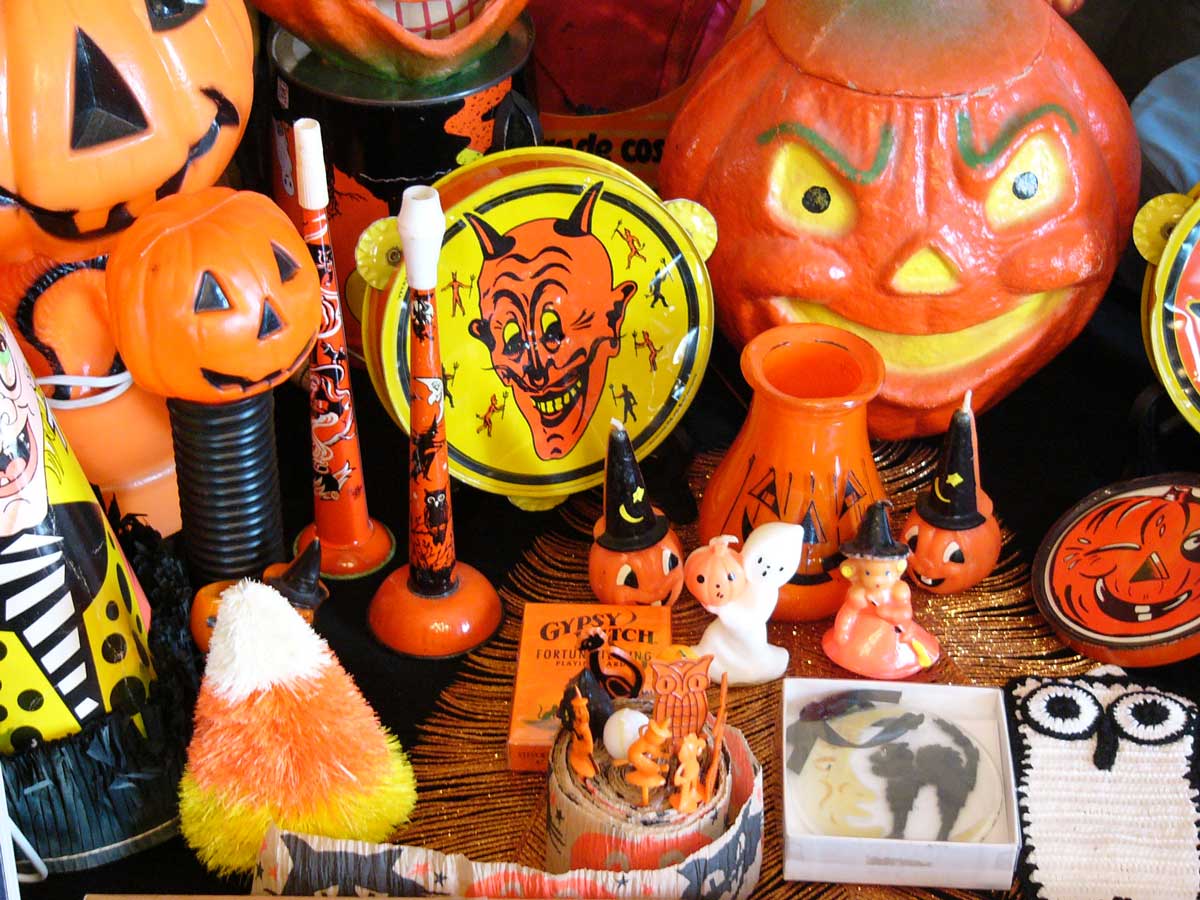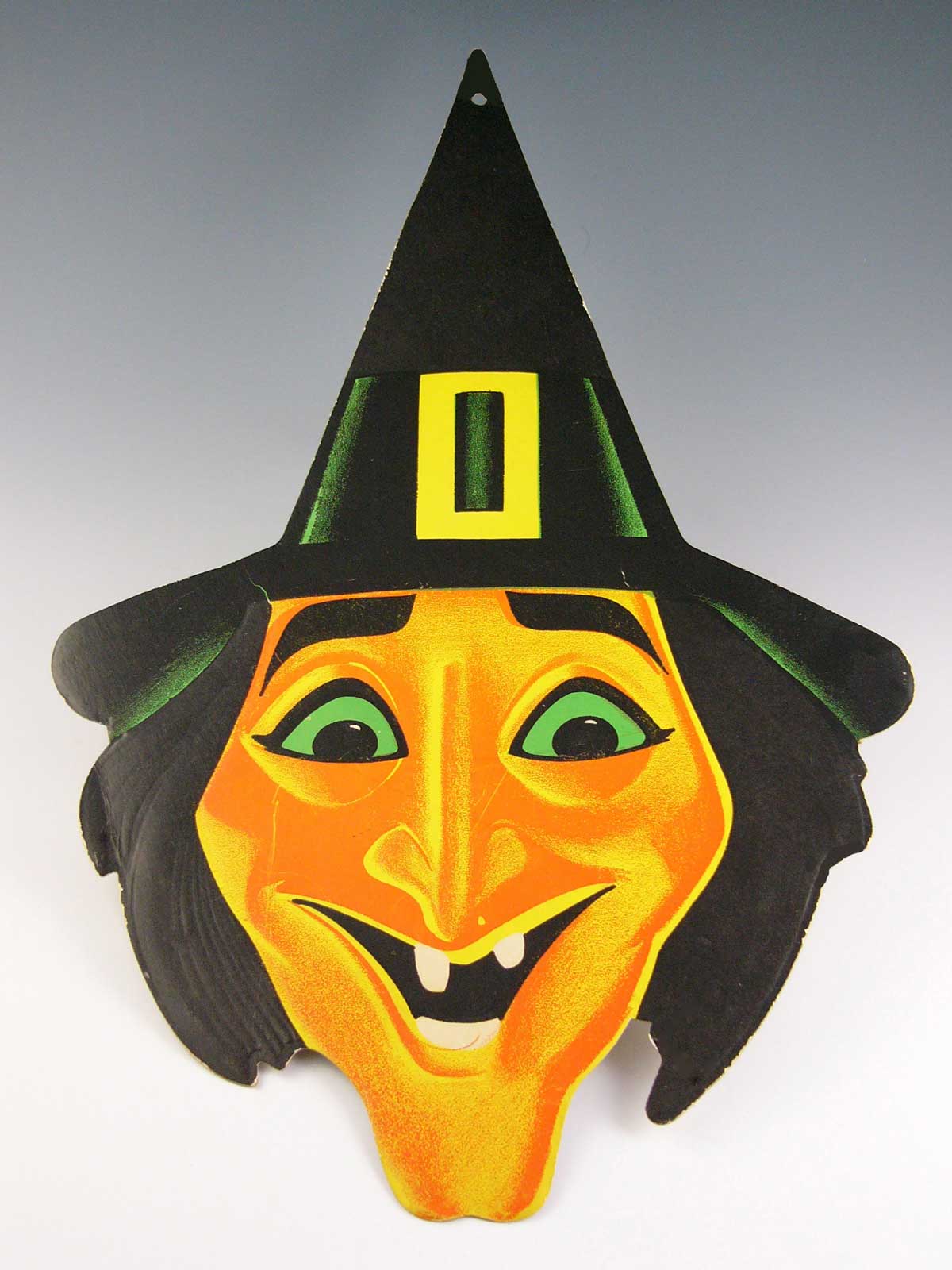October 2024
SMACK DAB IN THE MIDDLE
The collecting spirit: Haunting Halloween collectibles
by Donald-Brian Johnson
The scene: a suburban basement, circa 1960. Orange and black crepe paper streamers have been carefully taped to the rafters. Cardboard die-cut images of hags, haunts, and assorted other hobgoblins adorn the walls. On the floor sits a metal tub, awash in icy water and bobbing red apples. A honeycomb scarecrow centerpiece, engulfed by Indian corn and gourds, reigns atop the refreshment table. There, a bowl of “witch’s brew” (tropical punch with a slab of steaming dry ice), and plates of “cat cookies” (with gleaming candy corn eyes and fork-tine whiskers), await the hungry hordes. Near the foot of the stairs, an eerily grinning Jack-o’-lantern awaits his prey.
And slowly down the stairs they descend: pint-size devil imps and fairy princesses, friendly ghosts and wart-nosed witches, each lugging a stuffed-to-the-brim trick-or treat bag. Their fresh-out-of-the-box costumes (dime-store bargains that even included a mask), are at last making their long-awaited, once-a-year appearance.
It’s 1960, it’s Halloween, and the party is on!
Nowadays, Halloween is second only to Christmas as the biggest decorating holiday ever. We spend more than $6 billion annually on new and vintage Halloween decorations, costumes, treats, and other paraphernalia. Over one quarter of the candy sold each year is sold at Halloween (That fills a lot of trick-or-treat bags). Halloween décor items, both old and new, have been fashioned from die-cut cardboard, crepe paper, metal, composition, plastic, fabric, wax, and ceramic. Among the most popular depictions of things that go bump in the night: Jack-o’-lanterns, witches, skeletons, bats, and black cats.
Although Halloween collectors veer toward the vintage, they sometimes have a devil of a time finding exactly what they’re looking for. The relative rarity and corresponding priciness of Halloweenabilia is primarily because these were items of ephemeral shelf life. Die-cut cardboard cats and witches with accordioned crepe paper arms and legs were really only intended for one-time use. Hung with a lavish application of Scotch tape, or poked with thumb tacks, the pieces were often damaged, then discarded when the witching hour had passed. The reason? They were inexpensive, and next Halloween would bring a brand-new crop (One party goods manufacturer, Dennison, even published, for a time, an annual “Halloween Bogie Book” featuring the latest additions to their ghoulish décor line).
Prices can sometimes be on the scary side: a U.S.-made die-cut witch face from the 1950s can fetch up to $30. Her German-made pre-World War II sister can top out at an even scarier $150. Each originally sold at dime stores for well under a dollar.

Let the fun begin! A spook-tacular assortment of vintage Halloween decorations. Collectibles courtesy of Maureen Maher. (Image courtesy of the author)

Cardboard die-cut witch face, 20” h. Die-cut courtesy of Maureen Maher. (Image courtesy of the author)
Although few Halloween collectibles carry the mark of their maker, there are exceptions. Tin noisemakers often bear such stamped names as Chein, T. Cohn, and Bugle Toy. In many cases, kids’ Halloween costumes from such sources as Collegeville and Ben Cooper have interior identifying tags or are still in their original boxes. Gurley (formerly “Tavern”) candles, of spooky staples such as witches and ghosts, are also easily recognizable. That’s due not only to their singular styling, but also because Gurley pretty much cornered the marked on seasonal wax novelties. And, among the best-known, and certainly most carefully executed die-cut hanging pieces, are those by the Beistle Co. of Pennsylvania. The mark “H.E. Luhrs” (the name of the firm’s president) is a sure identifier of Beistle pieces produced during the 1940s and ‘50s.
While vintage Halloweenabilia remains today’s top draw, new decorative items incorporating vintage styling also have many fans. Like their vintage compatriots, modern Halloween interpretations are definitely for collectors not adverse to treating themselves. On the secondary market, a wire-skirted witch by 1800s-inspired artisan Nicol Sayre can reach a spellbinding $150.
When Oct. 31 rolls around, there’s magic at work. Somehow, it’s 1960 all over again. Those costumed kiddies are once again ready to make their way down into the Jack-o’-lantern’s lair. They’ll be amazed. Astounded. And maybe (just a little bit) frightened.
Halloween. What a boo-tiful occasion.

